This essay was prepared for the May 2024 NBER conference “Inflation in the COVID Era and Beyond.” The Romer and Romer paper it discusses, “Lessons from history for successful disinflation,” may be read here.
The Romers have written another fascinating narrative exploring the connection of monetary policy decision making and economic outcomes—in this case, the policy attitudes and approaches that led to substantial and long-lasting reductions in high inflation. The subject is of particular interest right now, of course, because the Federal Reserve is in the midst of an attempt to lower inflation from several decade highs after the COVID pandemic to its announced target of 2 percent.
Their conclusions, drawn from analysis of policy deliberations and policymakers’ public statements, seem obvious once you see them—but weren’t so clear and backed by evidence before the authors’ extensive examination. Successful disinflations, aside from those reflecting price controls or favorable supply shocks, require sustained commitment from the central bank. That commitment has encompassed a clear eye on the goal of price stability, including in some cases a numerical target; acceptance of responsibility for achieving price stability, encouraging but not relying on the policy actions of others to help achieve the goal; and a willingness to impose short-term pain in lost output to achieve the long-run gains associated with price stability.
They reinforce these conclusions by examining episodes of deliberate disinflations where one or more of these criteria for commitment were not met and restrictive policy was ended prematurely; they classify these as medium- and low-commitment disinflations. In those cases, policymakers were unwilling to accept the responsibility or unwilling to force the output losses required for complete success. In low commitment cases inflation may have flattened out after rising, but it did not fall much if at all from high levels; medium-commitment disinflations were marked by some, but incomplete disinflations. And they run statistical tests to show that their classifications of commitment are indeed correlated with the degree of disinflationary success.
In my comments I will extend their analysis to the 1982-1995 period when the disinflation begun in 1979 and 1981 was completed. Over this span, core PCE inflation fell from around 6 percent in the second half of 1982 to 2 percent in 1996, and the economy enjoyed what has been dubbed “the great moderation” of low inflation and damped business cycles—there was only one modest recession.1 The period was marked by several episodes in which policymakers did not push restrictive policy all the way to price stability. In the fall of 1982, the Federal Reserve backed off the “highly committed” disinflationary push identified by the authors for 1981 even as inflation remained around 6 percent; in 1984, 1988, and 1994 they tightened to stop inflation from rising, but did not hold on in order to hit an implied target. (The authors characterize the 1988 episode as “moderately committed,” and don’t address the others.) Yet policy succeeded in achieving price stability over this period, while minimizing deviations from full employment. I believe an examination of these episodes reveals policymakers engaged in a careful, nuanced weighing of the costs and benefits of pushing to price stability that may not fit easily within the authors’ criteria for successful disinflation.
The fall of 1982: backing off. In October 1979, the Federal Reserve recognized that it needed to make a dramatic shift in its approach to policy if it were to be effective in reducing inflation, which had climbed to around 7-1/2 percent over the summer. It abandoned the incremental changes to its interest rate target in favor of focusing on reserve provision tied to the growth of transactions money, M1. That shift resulted in federal funds rates rising from 11 percent in September 1979 to nearly 18 percent by March and April 1980. But rates subsequently fell sharply, partly responding under the new operating procedures to weak M1 and demand resulting from a Carter administration attempt at credit controls in early 1980. As controls were relaxed, the economy and inflation rebounded, the Committee recognized it had backed off too soon, and in 1981 it redoubled its commitment to reducing inflation through restrained growth in the monetary aggregates.
By the middle of 1982, core inflation had fallen from over 9 percent in early 1981 to around 6 percent, with an unemployment rate of nearly 10 percent and a funds rate of 13 percent. In its deliberations, the FOMC began to focus on a need to lower rates as inflation came down and the economy remained weak.2 M1 growth slowed over the summer, pulling the funds rate down into the 9 percent range under the reserve-focused procedures, but rates then rose in September as M1 accelerated, partly responding to increased demands for precautionary balances amid heightened financial and economic uncertainty. Chairman Paul Volcker viewed rising rates as not appropriate under the circumstances and convened a conference call of the FOMC during which he declared that he “would not find a mechanical application of the reserve provision rules suitable.” 3
The discussion at the October 5 FOMC meeting centered on domestic and global economic weakness and its feedback on confidence in U.S. banks. The unemployment rate was creeping up to over 10 percent and the expected recovery was not yet evident; disarray was developing in financial markets. Inflation had come down and sharp declines in bond yields over the summer indicated that attitudes and expectations about inflation had shifted markedly in a constructive direction. Committee members expressed strong aversion to rising interest rates under these conditions. “This was not a time for business as usual.” Comparisons were made to 1929 (and 1931) when the Federal Reserve had not responded adequately to the growing financial and economic emergency. In addition, deregulation of deposit interest rates under a new Congressional mandate, along with the maturation of an earlier tranche of time deposits issued under a temporary lifting of deposit rate ceilings, promised to enhance the demand for the very liquid transaction deposits in M1, further distorting that aggregate’s relationship to economic activity. 4
It was this latter development that Chairman Volcker emphasized in a speech and press conference later in October in which he announced that the FOMC would no longer be tying reserve provision and money market conditions to movements in M1. But, as evident in the discussion at the October FOMC meeting, backing off even while inflation was still unacceptably elevated reflected a more complete weighing of costs and benefits. With unemployment likely to remain high, inflation was expected to recede further now that attitudes had changed; problems in the oil patch (the failure of Penn Square Bank) and in Mexico, Brazil, and Argentina threatened large U.S. banks that had made considerable loans and investments there. Sustained high interest rates put financial and economic stability at risk. In his speech and press conference, Chairman Volcker emphasized that the FOMC remained committed to bringing inflation down further, but over time.
Summer 1984: tapping the brakes. The economy was growing robustly in the first part of 1984. The unemployment rate was at 8 percent and falling, inflation had decreased to around 4 percent but was rising, and the funds rate was in the neighborhood of 9-1/2 percent. At the same time, the financial system was again under considerable stress. In May, Continental Illinois Bank experienced a run as depositors took stock of the volume of bad petroleum-related loans the bank had purchased from Penn Square bank. Continental was stabilized in a controlled failure by the regulators, but its problems raised questions about other banks that might be similarly situated. At the same time, problems in developing countries, especially in Latin America, deepened and fed back on large U.S. banks. Through this period, policymakers were balancing the need to keep policy tight to slow growth to a more sustainable pace with concerns about the fragility of the financial system—sometimes characterized as on a knife’s edge.5
Under Federal Reserve operating procedures at the time, the FOMC instructed the New York Fed to maintain a level of bank borrowing from the discount window as a proxy for the federal funds rate. That rate had drifted up to around 10-1/4 percent by May. After Continental Illinois failed, banks reduced their demand for discount window loans at every funds rate out of concern about the vulnerability that might be conveyed by such borrowing. The backward shift in the borrowing function raised the funds rate at the FOMC’s specified borrowing target to about 11-1/2 percent by July, where it remained over the balance of the summer.
Of course, the reserve targeting procedures could have been overridden, as they had been in 1982. But they weren’t and, in my view, the tightening of financial conditions even as financial stability was under threat was critical for assuring the continuation of the disinflationary path and reinforcing its credibility. The growth of real GDP moderated from 7-1/2 percent (SAAR) in H1 to 3-1/2 percent in H2, and the rise in inflation was choked off as core PCE inflation slowed from over 4-1/4 percent in the first half to just under 4 percent in the second half of the year. With the economy growing strongly and the unemployment rate down considerably, the FOMC could weigh the costs and benefits of tightening in the face of financial vulnerabilities much differently than they did in the fall of 1982.
1988: limiting an upsurge. When Alan Greenspan took office in August 1987, inflation was 3-1/2 percent, but rising—it had been 2-3/4 percent in the first quarter of the year. The funds rate was also increasing—from 6-1/4 in the first quarter to 6-3/4 in August. Greenspan was determined to consolidate and extend the gains against inflation made under Volcker. He defined price stability as inflation so low it didn’t figure in the decision making of households and businesses, and he, along with the rest of the FOMC, recognized that it wasn’t there yet.
Thus, the tightening continued, and the funds rate reached around 7-1/4 percent in September and October. On October 19, however, stock prices plummeted, with the Dow Jones Industrial Average falling 22.6 percent in one day. The Federal Reserve responded with a promise to meet demands for liquidity and with some easing in the stance of policy, given the expected negative shock to demand from the destruction of wealth. Easing continued into early 1987, with the federal funds rate falling to around 6-1/2 percent in February.
By spring 1988, however, it had become clear that activity had considerable momentum in an economy already producing around estimates of full employment; policy needed to be tightened to head off a further acceleration of inflation, which had already picked up to a bit over 4 percent. Policy continued to be firmed into the spring of 1989, when the federal funds rate reached nearly 10 percent. Indicators available at that time suggested that economic growth was slowing and wage pressures were abating in response to earlier tightening. The FOMC eased policy slightly in a conference call at the beginning of June and followed that up with more easing at its early July meeting. By the end of the year, the funds rate was down to around 8-1/2 percent.
The authors cover this episode and characterize it as “medium commitment” in that the FOMC did not hold on to the tighter policy long enough to make inflation fall substantially; it did decline, but not until several years later. Part of the reason for easing off was a forecast that inflation would indeed move lower in coming years as the economy slowed; but, in addition, the Committee was not seeking an immediate and substantial decrease in price pressures. Rather, as Chairman Greenspan emphasized in his July 1989 Humphrey-Hawkins testimony, the FOMC was facing “a difficult balancing act”—the soft landing of continued growth but declining inflation because growth would be below potential. “We…recognize, however, that a degree of slack in labor and product markets will ease the inflationary pressures that have built up. So our policy, under current circumstances, is not oriented toward avoiding a slowdown in demand, for a slowing from the unsustainable rates of 1987 and 1988 is probably unavoidable. Rather what we seek to avoid is an unnecessary and destructive recession. The balance that we must strike is to support moderate growth of demand in the near term, while concurrently progressing toward our longer-run goal of a stable price level.”6 With inflation down to 4 percent, slow progress toward price stability was expected and acceptable, but rising inflation was inconsistent with achieving that goal and was not acceptable and had to be resisted.7
1994: pre-empting a rise in inflation and engineering a soft landing. In fact, growth did slow some in the second half of 1989 and first half of 1990. When Iraq’s invasion of Kuwait in August 1990 resulted in a sharp spike in oil prices and a hit to household and business confidence, the economy entered a recession, albeit one that turned out to be short (8 months) and mild (the unemployment rate rose from 5.5 to 6.8 over the recession). But the recovery was slow, the jobless rate continued to rise, and inflation fell further. Under the circumstances, the Federal Reserve took the unusual step of continuing to ease policy in the expansion. The federal funds rate was over 6 percent as the expansion began; one year later it was 4 percent and less than a year after that it had fallen to 3 percent, where it remained through 1993.
However, the economy grew very rapidly in late 1993, encouraged by the impetus from very accommodative monetary policy once borrower and lender balance sheets had been repaired from the effects of a real estate bust, and by greatly diminished margins of slack. Although inflation had not picked up—core PCE was at 2.5 per cent over the 12 months ending in December 1993—the FOMC saw the very accommodative stance of policy, characterized by a real funds rate around zero, as inconsistent with preventing an intensification of price pressures going forward given the momentum behind growth. At its February meeting it raised its target for the federal funds rate. The Committee saw some urgency to getting to a more neutral stance of policy, and rates rose steadily over the next year. By February 1995, the funds rate was at 6 percent, but inflation hadn’t increased, and the unemployment rate had fallen to around 5-1/2 percent.
The FOMC tightened policy slightly further in February, but the information coming in after that suggested that economic growth was slackening, reducing the risk of inflation intensifying, and policy went on hold for several months. By early July signs of softening in growth were accumulating, core PCE inflation had leveled out a little over 2 percent, and many members of the FOMC were predicting that inflation would fall further as below-trend growth opened up slack in labor and product markets. With the real funds rate seen as in at least slightly restrictive territory, the FOMC eased policy to avoid an unnecessary weakening in the economy.8
Although inflation had fallen to just over 2 percent on core PCE, many members did not consider this “price stability,” and the discussion at the July meeting and elsewhere acknowledged that further declines in inflation would be required to achieve that goal. This was a period in which several FOMC members backed a strategy called “opportunistic disinflation.” Under this strategy, once inflation had fallen to a fairly low level, the FOMC would not try to engineer economic slack to bring it all the way down, but would resist any increases and take advantage of favorable supply shocks or negative demand shocks that inadvertently opened up output gaps to get all the way to stability.9 Thus 1994-5 is another example, along with 1982, 1984, and 1988-89, of policymakers backing off disinflationary policy before they saw the way clear to price stability.10 By the late1990s core PCE inflation had fallen to just over one percent, with a helpful push from a favorable increase in productivity growth that damped labor costs.
Reflections. Arguably, the period of 1982 to the late 1990s is among the most successful of Federal Reserve monetary policymaking. Inflation fell from 6 percent to levels consistent with price stability, and that was accomplished with only one brief recession that importantly reflected elements outside of Federal Reserve causation or control. Yet this occurred while policymakers demonstrated only medium commitment to disinflation under the authors’ definition, as in the episodes just discussed, policy backed off from its restrictive stance before full price stability was clearly in sight; policymakers were unwilling to do “whatever it takes”.
The cost-benefit calculus behind imposing appreciable costs in lost output shifted once inflation had come off the very high rates of the 1970s and agents’ expectations and actions began to adjust to and anticipate lower rates. The Federal Reserve was not an “inflation nutter” ignoring output costs to achieve price stability; it was, in effect, a flexible inflation targeter, and the maximum employment leg of the dual mandate mattered. As inflation and its expectations declined, the FOMC saw itself as promoting public welfare by focusing more on keeping the economy near full employment—this was the logic behind opportunistic disinflation—provided inflation did not re-accelerate.
Several key characteristics of policymaking through this period contributed to its success. Critically, policymakers remained committed to reaching price stability over time. Monetary policy testimonies of Chairman Greenspan in the late 1980s and early 1990s regularly emphasized the importance of keeping inflation on a downward track. By eliminating the distortions of inflation, promoting price stability was how the Federal Reserve could best contribute to maximum employment and output for the US economy.11 And policymakers recognized that any output loss associated with getting to the price stability goal would be reduced by achieving public credibility for their intentions. Policy deliberations included frequent references to and concerns about inflation expectations, inferred in part from the movement of long-term interest rates. Chairman Greenspan’s February 1993 monetary policy testimony featured an extended discussion of the interactions among long-term rates, inflation expectations, and Federal Reserve credibility, pushing back against arguments that the FOMC should have eased more aggressively in 1992.12
Another important characteristic of policy was that it was forward looking, based on forecasts, however uncertain and subject to error they might have been. The FOMC tightened in anticipation of inflation picking up, leaning against building pressures in labor and product markets. Pre-emptive strategy was especially important to establish credibility for the Federal Reserve’s pursuit of its price stability objective after the high-inflation and premature policy reversals of the 1970s.
2021-24. The authors compare the recent words and actions of the Federal Reserve to the criteria they have identified for successful disinflations to judge the commitment of current policymakers to restoring price stability following the post-covid inflation. They find several reasons to be hopeful in this regard: There’s a strong commitment to the 2 percent target; policymakers are accepting responsibility for hitting the target; and they have evinced willingness to accept some weakness in labor markets to achieve it. Although the story isn’t over yet—as they write, inflation has come down a lot, but remains above target—they are optimistic about eventual success. I agree. The nearly unprecedented pace of policy tightening in 2022 and 2023 demonstrated the Fed’s commitment and backs the authors’ judgment.
The Federal Reserve, however, does have an opportunity to strengthen its commitment to price stability even further and the public’s understanding of it. The Fed is undertaking a five-year review of its “monetary policy strategy, tools, and communication” in 2024-25. This follows a review and adjustment of strategy in 2019-20 that aimed at adapting policy to the low-inflation, low-interest rate environment of 2009-19. This new strategy and its implementation took risks on the side of higher inflation, in part to offset the threat of policy rates being constrained by the effective lower bound on interest rates; arguably, this asymmetry contributed to a delayed response to the inflation surge of 2021-22.13
Several possible elements of the review would be key to capitalizing on the opportunity to bolster the price-stability commitment. It should:
- Start with lessons learned from the past five years; what went right, what went wrong, and why.
- Fully justify the chosen inflation target. In 2019, the Federal Reserve simply declared it wouldn’t change from the existing two percent target. Two may be the right number, but other targets have been suggested and commitment and understanding would be helped by explaining why a particular target had been chosen.
- Define maximum employment as the highest level of employment consistent with price stability. That would assure that the two sides of the dual mandate were consistent.
- Make sure the new framework is robust to a wide variety of economic circumstances. The framework should be able to address the low-rates, low-inflation situation of the 20 teens, but also other, more inflationary episodes.
- Re-examine the asymmetric approach to labor market tightness embodied in the 2020 framework. In that framework policy takes account of shortfalls from maximum employment, but not actual or projected overshoots. However, judgments about emerging labor market pressures were critical to the successful pre-emptive tightenings of 1984, 1988, and 1994 that we have been discussing. The Federal Reserve should take a particularly hard look at the costs and benefits of retaining the labor market asymmetries in the 2020 framework.
References
Eggertsson, Gauti, and Don Kohn. 2023. “The Inflation Surge of the 2020s: The Role of Monetary Policy.” The Brookings Institution. https://www.brookings.edu/events/the-fed-lessons-learned-from-the-past-three-years/.
FOMC. 1982a. “Transcript of September 1982 Federal Open Market Committee Conference Call.” Federal Reserve Board of Governors. https://www.federalreserve.gov/monetarypolicy/fomchistorical1982.htm.
FOMC. 1982b. “Transcript of July 1982 Federal Open Market Committee Meeting.” Federal Reserve Board of Governors. https://www.federalreserve.gov/monetarypolicy/fomchistorical1982.htm.
FOMC. 1982c. “Transcript of October 1982 Federal Open Market Committee Meeting.” Federal Reserve Board of Governors. https://www.federalreserve.gov/monetarypolicy/fomchistorical1982.htm.
FOMC. 1984. “Transcript of May 1984 Federal Open Market Committee Meeting.” Federal Reserve Board of Governors. https://www.federalreserve.gov/monetarypolicy/fomchistorical1984.htm.
FOMC. 1995. “Transcript of July 1995 Federal Open Market Committee Meeting.” Federal Reserve Board of Governors. https://www.federalreserve.gov/monetarypolicy/fomchistorical1995.htm.
Greenspan, Alan. 1989. “Testimony from July 1989 Humphrey-Hawkins Act Hearings.” Federal Reserve Bank of St. Louis. https://fraser.stlouisfed.org/title/monetary-policy-oversight-672/conduct-monetary-policy-22409.
Greenspan, Alan. 1993. “Testimony from February 1993 Humphrey-Hawkins Act Hearings.” Federal Reserve Bank of St. Louis. https://fraser.stlouisfed.org/title/statements-speeches-alan-greenspan-452/semiannual-monetary-policy-report-congress-8479.
Kohn, Don. 1996. “Commentary: What Operating Procedures Should Be Adopted to Maintain Price Stability?—Practical Issues.” Federal Reserve Bank of Kansas City. https://www.kansascityfed.org/research/jackson-hole-economic-symposium/achieving-price-stability/.
Orphanides, Athanasios, and David W. Wilcox. 1997. “The Opportunistic Approach to Disinflation.” Federal Reserve Board of Governors. https://www.federalreserve.gov/econres/feds/the-opportunistic-approach-to-disinflation.htm.
-
Acknowledgements and disclosures
The author consults for T. Rowe Price and is a member of the board of Forbright Bank. Neither contributed to this research. The Brookings Institution is financed through the support of a diverse array of foundations, corporations, governments, individuals, as well as an endowment. A list of donors can be found in our annual reports published online here. The findings, interpretations, and conclusions in this report are solely those of its author(s) and are not influenced by any donation.
-
Footnotes
- All the inflation data used in this comment are 12-month readings on the core PCE measure, as currently recorded.
- FOMC (1982b).
- FOMC (1982a).
- FOMC (1982c).
- FOMC (1984).
- Greenspan (1989).
- That testimony ends by reinforcing the price stability objective coupled with an acknowledgement of the possibility of policy mistakes. “Moreover, I cannot rule out a policy mistake as the trigger for a downturn. We at the Federal Reserve might fail to restrain a speculative surge in the economy or fail to recognize that we were holding reserves too tight for too long. Given the lags in the effects of policy, forecasts inevitably are involved and thus errors inevitably arise. Our job is to keep such errors to an absolute minimum. An efficient policy is one that doesn’t lose its bearings, that homes in on price stability over time, but that copes with and makes allowances for any unforeseen weakness in economic activity. It is such a policy that the Federal Reserve will endeavor to pursue.” https://fraser.stlouisfed.org/title/monetary-policy-oversight-672/conduct-monetary-policy-22409.
- FOMC (1995).
- See Orphanides and Wilcox (1997) for an explanation of the rationale. See also Kohn (1996) for my commentary at the 1996 Jackson Hole symposium.
- Kohn cites 1984, 1988, and 1994 as examples of opportunistic disinflation in practice.
- See numerous testimonies on the semi-annual monetary policy report to Congress at https://fraser.stlouisfed.org/title/statements-speeches-alan-greenspan-452?browse=1990s
- Greenspan (1993).
- For an argument that the new framework did play a role see Eggertsson and Kohn (2023).
The Brookings Institution is committed to quality, independence, and impact.
We are supported by a diverse array of funders. In line with our values and policies, each Brookings publication represents the sole views of its author(s).

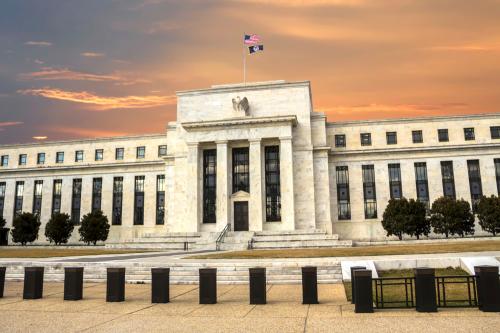
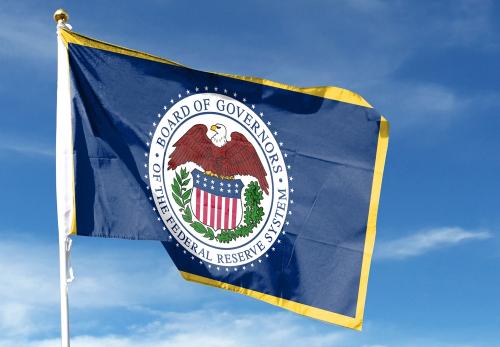
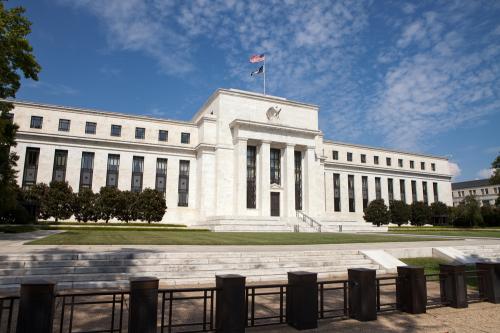

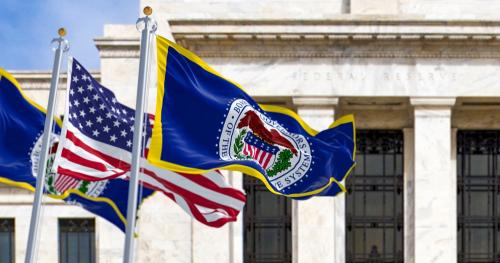
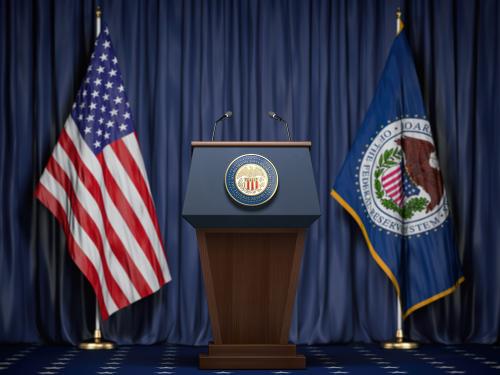
Commentary
Comments on “Lessons from history for successful disinflation” by Christina D. Romer and David H. Romer
July 25, 2024